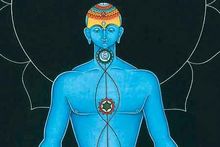The path to success or achieving a goal is never easy. Every task or goal has its unique challenges and roadblocks. Merle Miller says: “Everyone has his burden. What matters is how you carry it.”
Quotes of people who have achieved monumental success in different walks of life serve as a source of inspiration and help in keeping us in good stead. Despite repeated failures and all sorts of adversities, they never gave up hope and continued to work hard with the ‘never say die’ spirit. Showing a positive attitude during stressful times at any point of time in our life will make a big difference.
Why do negative thoughts hold sway at times? Swami Sivananda says that uncontrolled thoughts render the mind weak as a result of which negative thoughts dominate. If you carefully observe your thought patterns, you will find that many thoughts are inconsistent. The mind wanders at random aimlessly. There will be some thoughts of household issues, some thoughts of bank balance, some of eating and drinking, some of going to a movie, and so many others.
It has often been observed that when you are absorbed in studying a book at 7 pm the expectation of pleasure at watching a cricket match on TV at 8 pm distracts your attention every now and then. When it is time to meditate, one thinks instead of sleep, and when the head nods one dive into bed and starts snoring and that is the end of meditation! The will is thus buried. Paramhansa Yogananda says that man’s brain is full of ‘cant’s’ which have to be cauterized in order to be successful in life. You have within you the power to accomplish everything you want; that power lies in the will.
It is therefore of paramount importance that one should analyse dispassionately one’s thought patterns for at least fifteen minutes every day, preferably early in the morning. Introspection will tell us that each of our habits creates a specific ‘groove’ in the brain and that these patterns make us behave in a certain way, often against our wish. However, through the practice of concentration and meditation, one can neutralise the dictates of these bad habits by creating thought patterns of good habits.
For example, thoughts of hatred and anger should be controlled by generating thoughts of forgiveness, mercy and nonviolence; thoughts of pride and arrogance should be eradicated through inculcating thoughts of humility and a down-to-earth attitude; greed and possessiveness should be dispelled by pursuit of magnanimity, contentment and non-covetousness; jealousy and meanness should be replaced with thoughts of love and generosity; and, above all, delusion and infatuation are best overcome by constant Self-inquiry and developing the power of discrimination.
Quotes of people who have achieved monumental success in different walks of life serve as a source of inspiration and help in keeping us in good stead. Despite repeated failures and all sorts of adversities, they never gave up hope and continued to work hard with the ‘never say die’ spirit. Showing a positive attitude during stressful times at any point of time in our life will make a big difference.
Why do negative thoughts hold sway at times? Swami Sivananda says that uncontrolled thoughts render the mind weak as a result of which negative thoughts dominate. If you carefully observe your thought patterns, you will find that many thoughts are inconsistent. The mind wanders at random aimlessly. There will be some thoughts of household issues, some thoughts of bank balance, some of eating and drinking, some of going to a movie, and so many others.
It has often been observed that when you are absorbed in studying a book at 7 pm the expectation of pleasure at watching a cricket match on TV at 8 pm distracts your attention every now and then. When it is time to meditate, one thinks instead of sleep, and when the head nods one dive into bed and starts snoring and that is the end of meditation! The will is thus buried. Paramhansa Yogananda says that man’s brain is full of ‘cant’s’ which have to be cauterized in order to be successful in life. You have within you the power to accomplish everything you want; that power lies in the will.
It is therefore of paramount importance that one should analyse dispassionately one’s thought patterns for at least fifteen minutes every day, preferably early in the morning. Introspection will tell us that each of our habits creates a specific ‘groove’ in the brain and that these patterns make us behave in a certain way, often against our wish. However, through the practice of concentration and meditation, one can neutralise the dictates of these bad habits by creating thought patterns of good habits.
For example, thoughts of hatred and anger should be controlled by generating thoughts of forgiveness, mercy and nonviolence; thoughts of pride and arrogance should be eradicated through inculcating thoughts of humility and a down-to-earth attitude; greed and possessiveness should be dispelled by pursuit of magnanimity, contentment and non-covetousness; jealousy and meanness should be replaced with thoughts of love and generosity; and, above all, delusion and infatuation are best overcome by constant Self-inquiry and developing the power of discrimination.
Aristotle says: “The energy of the mind is the essence of life. It is our attitude which brings in thoughts and shows us the true outlook of life. Lots of patience is required to maintain a positive attitude. One must remember that we become whatever we think. So, we must give everything to prevent negative thoughts replacing positive thoughts”.
Indeed, it has been rightly said: “As a man thinketh, so he becometh”!
